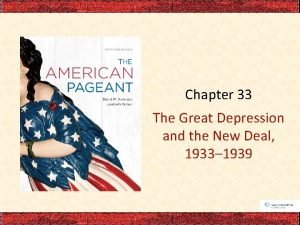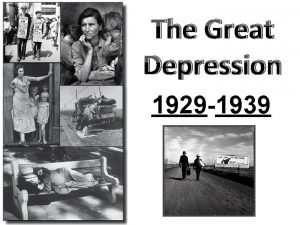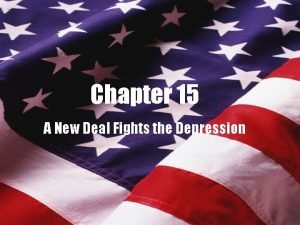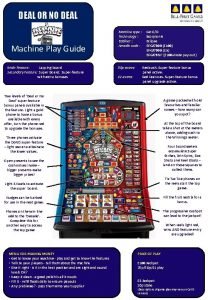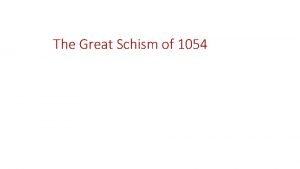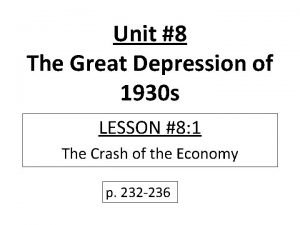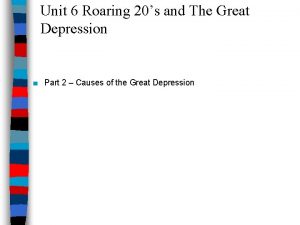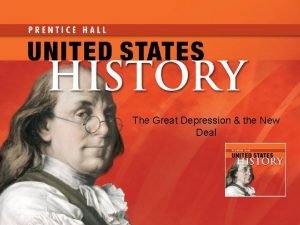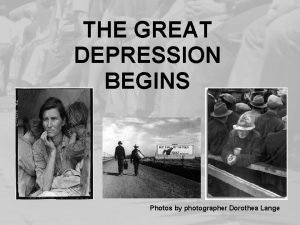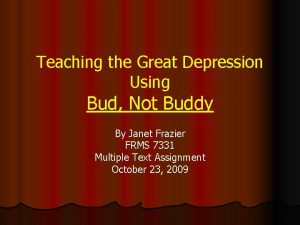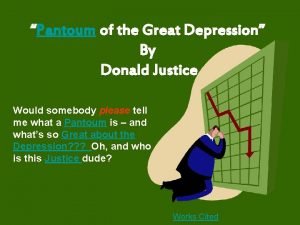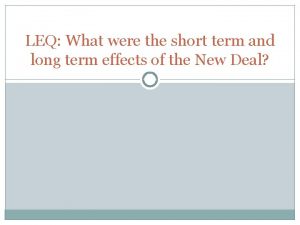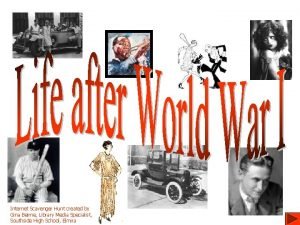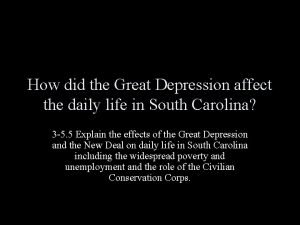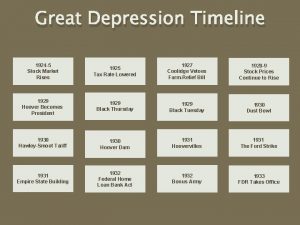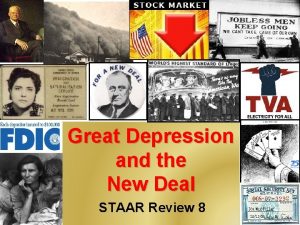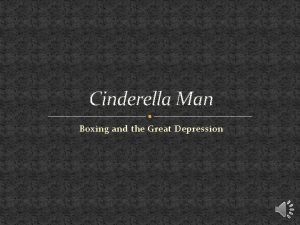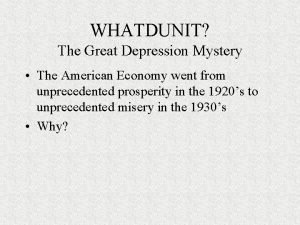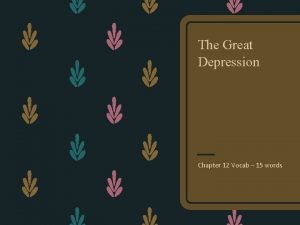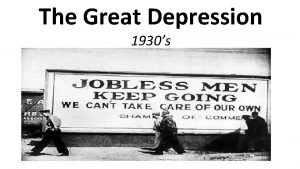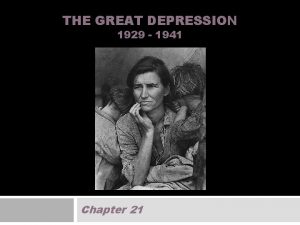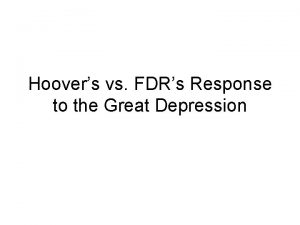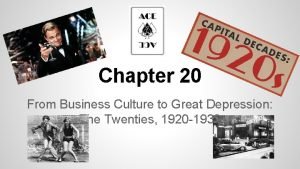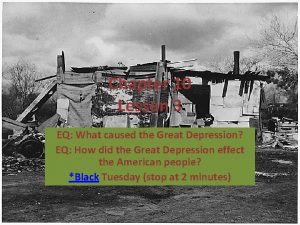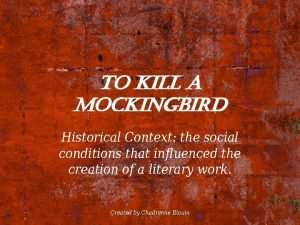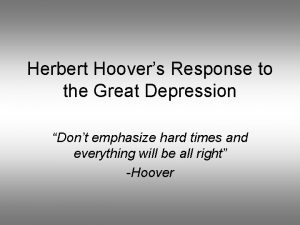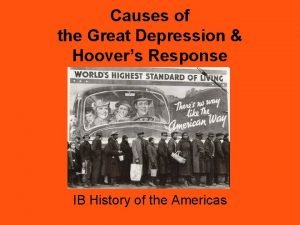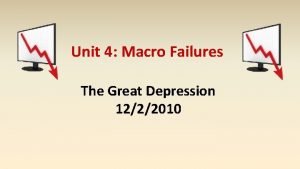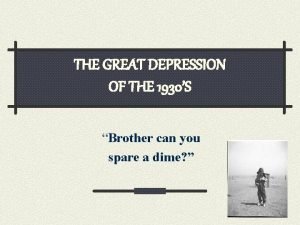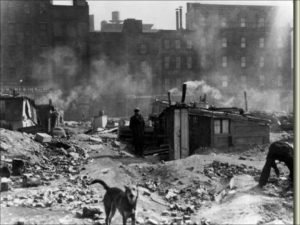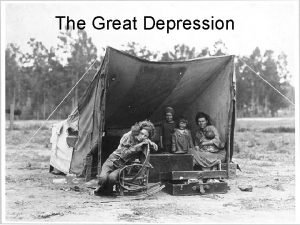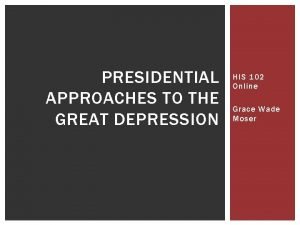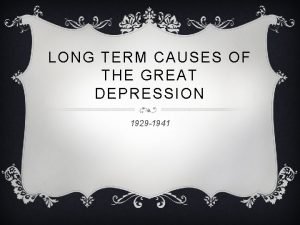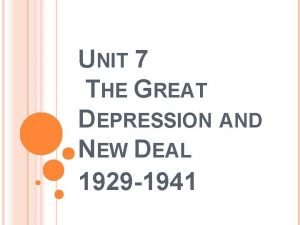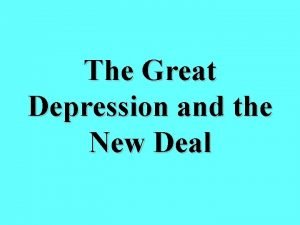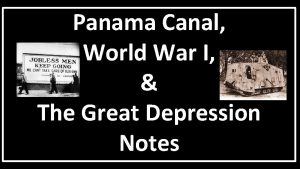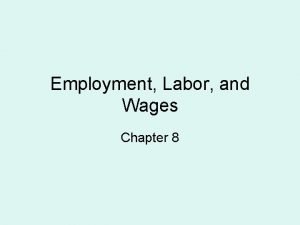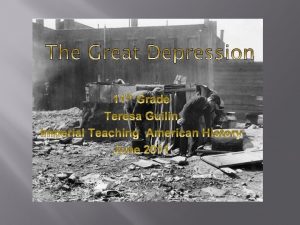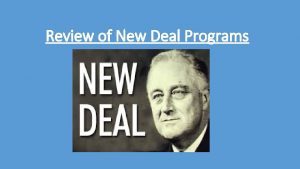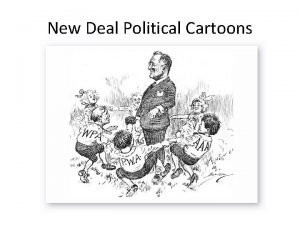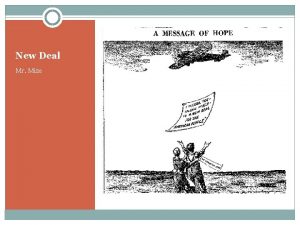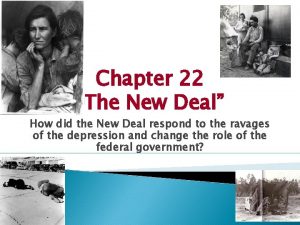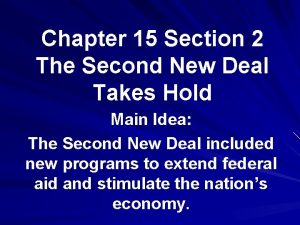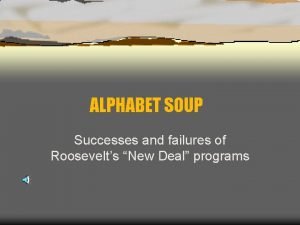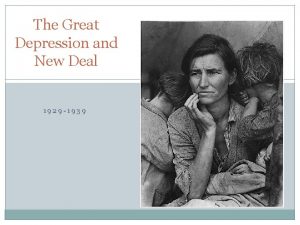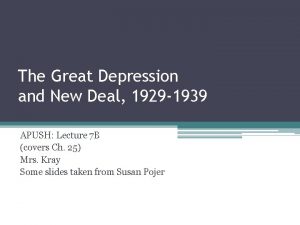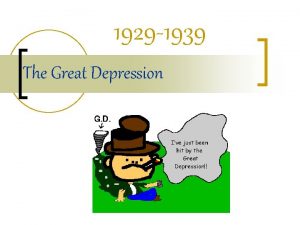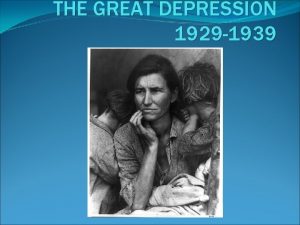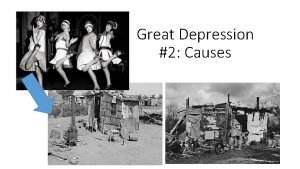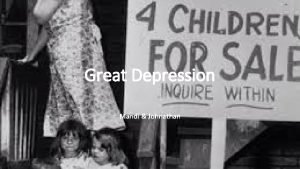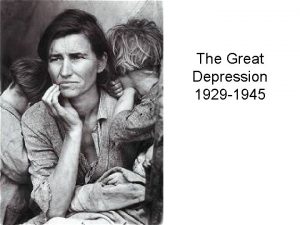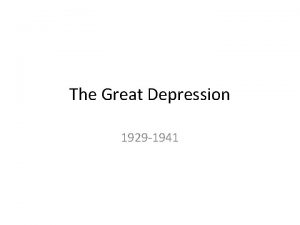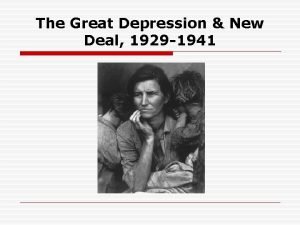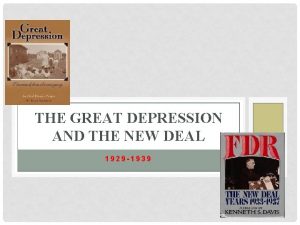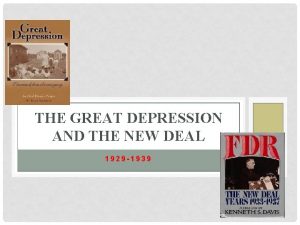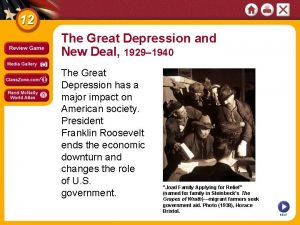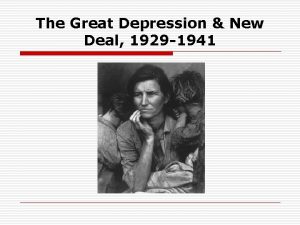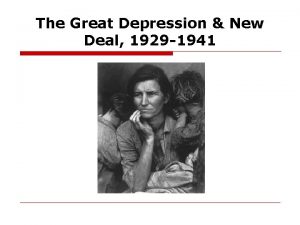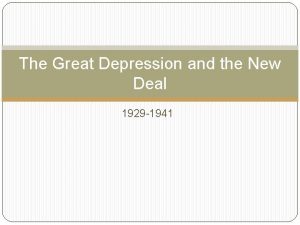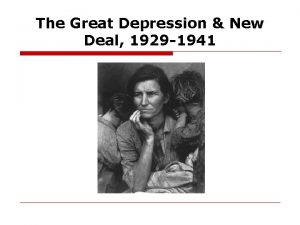The Great Depression New Deal 1929 1939 Speculative

























































































- Slides: 89

The Great Depression & New Deal 1929 -1939

Speculative Manias • Ponzi scheme, 1919 • Florida Land Boom – 1926 Hurricanes • Stock Market Boom of 1928 and 1929 – AT&T: 179½ to 335⅝ – GM: 139¾ to 181⅞ – Westinghouse: 91⅝ to 313 • Buying stock on margin – By 1929, 1. 5 million Americans had purchased stocks

Speculative Manias

The Market Crashes • Thursday, October 24, 1929 – Stock values plunged by $11 billion – “the fundamental business of the country. . . is on a sound and prosperous basis. ” • Black Tuesday, October 29, 1929 – Trading volume reached a record high of 16, 410, 030 shares; loss of 12 percent in one day – By 1932, stock exchanges lost $179 billion in value

The Market Crashes

The Market Crashes • By 1933: – Unemployment reached 25% of workforce (was 3. 2% in 1929) – Industrial production declined by 50% – Investment in U. S. economy fell from $16 billion to $340 million; a decrease of 98%

Why It Happened • “Prosperity’s decade”: – Employment was high (96. 8%) and inflation was virtually nonexistent – Industrial production had risen 30 percent between 1919 and 1929 – Per capita income had risen from $520 to $681 – United States accounted for nearly half the world’s industrial output – “Seeds” of depression were present in “boom” of the 1920 s

Why It Happened • Prosperity as an illusion: – More than 60% of families earned less than $2000/year ($2500 considered necessary) – 40% earned less than $1500 annually – Wages stagnated or fell in mining, transportation, and manufacturing due to electrification and more efficient management

Why It Happened • Prosperity bypassed some Americans entirely: – 71% of Native Americans earned less than $200 a year – During each year of the 1920 s, 25, 000 Mexican Americans migrated to the U. S. – Mexican Americans lived in conditions of extreme poverty; virtually no meat or fresh vegetables in their diet

Why It Happened • Farmers had been in depression since 1921 • Following World War I and end of government price supports, farm prices plummeted • European agriculture revived and grain from Argentina and Australia entered world market • In 1910, a farmer’s income was 40% of a city worker’s; by 1930, it had dropped to 30% • Millions of farmers defaulted on debts, placing tremendous pressure on banking system • Between 1920 and 1929, more than 5, 000 banks failed (17% of all banks)

Why It Happened • Because of banking crisis, thousands of small businesses failed to secure loans; thousands more went bankrupt after the stock market crash • Heavy burden of consumer debt also weakened the economy; consumers cut back on discretionary spending in late 1920 s • This led to reductions in production and subsequent worker layoffs; unemployed workers spent less, and the cycle continued

Why It Happened • Maldistribution of wealth: – Between 1919 and 1929, share of income received by wealthiest 1 percent rose from 12 percent to 19 percent – Share of income received by wealthiest 5 percent rose from 24 percent to 34 percent – Poorest 93 percent nonfarm population saw its disposable income fall in 1920 s – Rich spent a high proportion of income on luxuries and saved disproportionately large share of their income – insufficient demand to keep employment and investment at a high level

Why It Happened • Business investment fell before 1929; housing fell to less than half of 1924 levels (National Origins Act of 1924) • Soaring inventories led businesses to reduce investment and production in late 1920 s; surplus funds went into stock market speculation • Federal Reserve also weakened economy; slow the growth of money supply to curb stock market speculation and then allowed money supply to fall dramatically after crash – “liquidity crisis”

Why It Happened • Consumers were unable to repay loans and businesses did not have capital to finance operations • Federal Reserve should have cut interest rates and expanded money supply; instead money supply declined by 27 percent between 1929 and 1933 • Republican tariff policies damaged economy by depressing foreign trade: – Fordney-Mc. Cumber Tariff of 1922 – Hawley-Smoot Tariff of 1930 – Depressed foreign economies, increased foreign tariffs and international trade plummeted 30% by 1933

Why It Happened • Depression did not strike instantly – infected country gradually like a slow cancer • Worst economic catastrophe in American history • Hit urban and rural areas, blue- and white-collar workers • Causes homelessness, starvation, and poverty • Relief burden fell on state/municipal governments and private charities due to lack of federal system of unemployment insurance • These groups lacked the resources to alleviate massive suffering; poor Southerners were especially hard hit

Only Yesterday (1931)

Woody Guthrie

Global Perspective • Military dictatorships – Central & South America • Fascism and Militarism – Germany, Italy, and Japan • Totalitarian communism – Soviet Union • Welfare capitalism – Canada, Great Britain, and France • The economic decline brought on by the depression was steeper and more protracted in the United States than in other industrialized nations

Global Perspective • The Great Depression transformed the American political and economic landscape: Produced a major political realignment, creating a coalition of big city ethnicities, African Americans, and Southern Democrats, committed to an interventionist government Strengthened the federal presence in American life; national old-age pensions, unemployment compensation, aid to dependent children, public housing, federally subsidized school lunches, insured bank deposits, minimum wage, and stock market regulation

Global Perspective Altered labor relations, producing a revived labor movement and a national labor policy protective of collective bargaining Transformed the farm economy by introducing federal price supports and rural electrification Produced a fundamental shift in public attitudes – led Americans to view the federal government as their agency of action and reform and the ultimate protector of the public’s well-being

The Human Toll • Breadlines, soup kitchens, tin-can shanties and “Hoovervilles” • “Arkies” and “Okies”

The Human Toll • Unemployment: – 1929 – 3 million – 1930 – 4 million – 1931 – 8 million – 1932 – 12. 5 million • 90% of companies cut worker pay; 75% of all workers were on part-time schedules • By 1933, the average family income fell 40%; multiple families crowded in one-room shacks, caves, and even sewer pipes!

The Human Toll • Vagrancy shot up as families were evicted • Many families planted gardens, canned food, bought old bread and used cardboard and cotton for shoe soles • Many did without milk or meat; neglected medical and dental care • “Nobody is actually starving. The hoboes are better fed than they ever have been. ” • In 1931, 20 known cases of starvation in NYC; 110 in 1934

The Human Toll • Couples delayed marriage and birthrate declined below the replacement level for first time in American history • Divorce rate also fell; rates of desertion soared – By 1940, 1. 5 million married women lived apart from their husbands; 200, 000 vagrant children wandered the country • Depression inflicted heavy psychological toll on jobless men; many turned to alcohol or became abusive

The Human Toll • Women saw their status rise during the Depression; married women entered the workforce in large numbers • Depression also drew some families closer together; devised strategies for survival • Drew comfort from religion; increasingly looked to the federal government for help

The Dispossessed • Minorities (African Americans and Mexican Americans) suffered the most • 70% of Charleston’s black population and 75% of Memphis’ black population was unemployed • In the South, living conditions for black families were deplorable; income averaged less than a dollar a day • In the North, conditions were also distressed • Mexican Americans faced opposition from labor unions; “repatriation” sent more than 400, 000 to Mexico

The Dispossessed

Private and Public Charity • Great Depression overwhelmed private charities and local governments • In 1932, total public and private relief expenditures amounted to only $317 million - $26 per each unemployed American

President Hoover Responds • Most political and economic leaders viewed recessions as natural parts of the business cycle • Government intervention was unnecessary and unwise • Hoover saw the Great Crash as a temporary slump in a fundamentally healthy economy, but believed the president should try to facilitate economic recovery.

President Hoover Responds • First, Hoover resorted to jawboning – Summoned business and labor leaders and obtained promises; volunteerism • Second, he tried cheerleading; speeches assured Americans that economy was sound and recovery was around the corner – “Hoovervilles, ” “Hoover blankets, ” “Hoover flags” – Hoover was tormented by poor, but could not sanction large-scale federal public works programs (private sector, balanced budget, individual character – “rugged individualism”)

President Hoover Responds • • Hawley-Smoot Tariff of 1930 Boulder Dam (1931 -1936) 1932 Revenue Act Reconstruction Finance Corporation (RFC), 1932 • Federal Home Loan Bank System, 1932 • Emergency Relief Organization

Election of 1932 Herbert Hoover Franklin D. Roosevelt Republican Democrat

Bonus Army, 1932 “Well, this will elect me. ”

Election of 1932

Franklin Delano Roosevelt (1933 -1945)

First Hundred Days • • “The only thing we have to fear, is fear itself” Launched First New Deal immediately 3 “Rs” of New Deal: Relief, Recovery, and Reform 20 th Amendment (1933) March 9 – Emergency Banking Relief Act March 12 – first “fireside chat” “Capitalism was saved in eight days. ” March 22 – Beer-Wine Revenue Act (21 st Amendment) • May 12 – Federal Emergency Relief Act

First Hundred Days • June 13 – Homeowners Loan Act • June 16 – Glass-Steagall Act – Federal Deposit Insurance Corporation (FDIC) • Took the nation off the gold standard, devalued the dollar, ordered Federal Reserve to ease credit • Securities and Exchange Commission (SEC), 1934 • Other important laws in First Hundred Days included Agricultural Adjustment Act (AAA), National Industrial Recovery Act (NIRA), and Tennessee Valley Authority Act (TVA)

New Dealers • New breed of government officials: Ivy League intellectuals and social workers – “brain trust” • Strongly influenced by Progressive reformers; but much more pragmatic – Government had the duty to intervene in all aspects of the economy to improve quality of American life – Prophylactics in World War I • Rejected laissez-faire orthodoxy

New Dealers • Disagreed on best way to end the depression: – “Trustbusters” led by Thurman Arnold called for vigorous enforcement of antitrust laws to break up concentrated business power – “Associationalists” wanted to encourage cooperation between business, labor, and government by establishing associations and codes – Economic planners led by Rexford Tugwell, Adolph Berle, and Gardiner Means, wanted to create a system of centralized national planning

Farmers’ Plight • Farmers were hardest hit by depression; farm income fell two-thirds in just three years • Overproduction was still the culprit; increased worldwide production and lesser demand • Farm tenancy rose; 40% of all farmers did not own their own land – cycle of debt • Nature turned against farmers: boll weevil in the South and Dust Bowl in the West – Overgrazing by cattle, increased tractor use, and drought combined to create powerful dust storms – By 1939, one million Dust Bowl refugees left the plains to find work in California (“Arkies” and “Okies”)

Dust Bowl

Dust Bowl

Farmers’ Plight • As late as 1935, 6 million of America’s 6. 8 million farms had no electricity • Tennessee Valley Authority (TVA), 1933 • Rural Electrification Administration (REA), 1935 • Soil Conservation Service, 1936 • Farm Credit Administration, 1933 • Commodity Credit Corporation, 1933

Farmers’ Plight • Agricultural Adjustment Act (AAA), 1933 – Led by Secretary of Agriculture Henry Wallace – Would raise farm prices by reducing supply; participation was voluntary, but farmers would be paid to not grow crops – In 1933, farmers ordered to plow under the crops; 10 million acres of cotton destroyed and 6 million pigs were slaughtered – Mixed record: raised farm income but did little for sharecroppers and tenant farmers – forced at least 3 million more small farmers off the land – Established the precedent for a system of farm price supports, subsidies, and surplus purchases

Industry and Labor • National Industrial Recovery Act (NIRA), 1933 – National Recovery Administration (NRA) – Representatives of business, labor, and government would set prices, production levels, minimum wages, and maximum hours within each industry; supported labor unions; General Hugh Johnson – Over 500 industries, covering 22 million workers signed codes – Success was short lived; NRA Boards were dominated by leaders of big business – Abolished child labor and established federal regulation of minimum wages and maximum hours; labor membership expanded

Jobs Programs • Public Works Administration (PWA), 1933 – “pump primer”: providing people with money to spend on industrial goods – Led by Harold Ickes; spent $6 billion • Civilian Conservation Corps (CCC), 1933 – Employed 300, 000 jobless young men (18 -25) in nation’s parks and forests • Civil Works Administration (CWA), 1933 – Led by Harry Hopkins; 4 million men – Built 250, 000 miles of road, 40, 000 schools, 150, 000 privies, and 3, 700 playgrounds

Jobs Programs

Jobs Programs • CWA scrapped in 1934 to avoid budget deficit • 1934 Labor Day strike; 500, 000 garment workers • Democrats won more seats in Congress in 1934 midterm elections • Roosevelt abandoned his hopes for balanced budget, lost faith in government planning and alliances with business – only government spending remained an option

Jobs Programs • Works Progress Administration (WPA), 1935 – Employed 3. 5 million workers at a “security wage”; led by Harry Hopkins – Constructed or improved 2, 500 hospitals, 5, 900 schools, 1, 000 airport fields, and 13, 000 playgrounds – By 1941, it had pumped $11 billion into economy • • Farm Security Administration (FSA) Federal Writer’s Project (FWP) Federal Art Project (FAP) Federal Theater Project (FTP)

Jobs Programs • WPA established the precedent of federal support to the arts and the humanities • WPA also marked the zenith of Roosevelt’s influence over Congress

Roosevelt’s Critics Huey Long “Share Our Wealth” Father Charles Coughlin Dr. Francis Townsend National Union for Social Justice “Townsend Plan”

Labor • Launched Second New Deal and “Second Hundred Days” in Summer 1935 • Workers in major industries were not unionized • Wagner Act (National Labor Relations Act) of 1935 – Government guaranteed the right of employees to form unions and bargain collectively – Set up National Labor Relations Board (NLRB) which had the power to prohibit unfair labor practices by employers • Fair Labor Standards Act of 1938

Labor • Dispute broke out within labor’s ranks: Should labor focus its efforts on unionizing skilled workers; or go after all workers in industry regardless of skill? • AFL focused on skilled labor • In 1935, John L. Lewis (United Mine Workers) helped organized Committee for Industrial Organizations within AFL • In 1938, CIO was expelled and formed Congress of Industrial Organizations

Labor • 1937 United Auto Workers “Sit-down” Strike in Flint, Michigan • 1937, U. S. Steel accepted unionization • Memorial Day Massacre, 1937 in Chicago at Republic Steel mill – part of “Little Steel” • 1941, NLRB forced “Little Steel” to recognize unions and reinstate all workers fired for union activity


Social Security • Social Security Act, 1935 – Social Security Administration (SSA) – Provided aid to the elderly, disabled, dependent children without wage-earning parents – Established first federally sponsored system of unemployment insurance – Based on mandatory payroll deductions – Conservatives argued that the SSA placed America on the “road to Socialism” – Reformers wanted “cradle to grave” protection

Social Security • New system offered pitifully small payments • Left huge groups of workers uncovered: migrant workers, civil servants, domestic servants, merchant seamen, and day laborers • Budget came from a regressive tax policy • Did not provide health insurance Committed government to a social welfare role and greatly expanded the public’s sense of entitlement from government

Second New Deal • Public Utility Holding Company Act, 1935 • Second New Deal also included more banking reform and a new tax proposal; 2 nd AAA • Second New Deal sought to make capitalism more humane; majority of Americans did not want dramatic changes and Roosevelt never achieved a social revolution • There were no attacks on private property; wealthy retained their privileges and wealth – the rich were still rich and poor were still poor

Second New Deal • Wealthy viewed Roosevelt as a traitor to his class; William Randolph Hearst ordered his newspapers to substitute “Raw Deal” for “New Deal” • Conservatives were appalled by deficit spending and expansion of the federal bureaucracy; feared attacks on states’ rights and individual liberties as well as higher taxes on the wealthy

Rejected (Author Unknown) A stranger stood at the gates of Hell And the Devil himself had answered the bell. He looked him over from head to toe And said, "My friend, I'd like to know What you have done in the line of sin To entitle you to come within? “ Then Franklin D. , with his usual guile, Stepped forth and flashed his toothy smile. "When I took charge in thirty-three A nation's faith was mine, " said he. "I promised this and I promised that And I calmed them down with a fireside chat.

Rejected I spent their money on fishing trips And fished from the deck of their battleships. I gave them jobs on the P. W. A. Then raised their taxes and took it away. I raised their wages and closed their shops I killed their pigs and burned their crops. I double crossed both old and young And still the fools my praises sung. I brought back beer, and what do you think? I taxed it so high that they couldn't drink. I furnished money with Government loans, When they missed a payment, I took their homes.

Rejected When I wanted to punish the folks, you know, I'd put my wife on the radio. I paid them to let their farms lie still And imported food-stuffs from Brazil. I curtailed crops when I felt real mean And shipped in corn from the Argentine. When they started to worry, stew and fret I'd get them to changing the alphabet. With the A. A. A. and N. L. R. B. The W. P. A. and the C. C. C. With these many units I got their goats And still I crammed it down their throats.

Rejected My workers worked with the speed of snails While the tax payers chewed their fingernails. When the organizers needed dough I closed up the plants for the C. I. O. I ruined jobs and I ruined health And I put the screws on the rich man's wealth. And some, who couldn't stand the gaff, Would call on me, and how I'd laugh! When they got too strong on certain things I'd pack and head for old Warm Springs. I ruined their country, their homes and then I placed the blame on "nine old men".

Rejected Now Franklin talked both long and loud And the Devil stood and his head he bowed. At last he said, "Let's make it clear, You'll have to move. You can't stay here! For once you mingle with this mob, I'll have to hunt myself a job. "

Election of 1936 Alfred M. Landon Franklin D. Roosevelt Republican Democrat

Election of 1936 New Deal Coalition: poor people, organized labor, urban ethnics, Democratic South, African Americans, and many intellectuals

Eleanor Roosevelt

Women • Government jobs in Washington opened to women because of New Deal programs (prior experience with social work and voluntary associations) • Frances Perkins, secretary of labor and first female cabinet member • Molly Dewson, director of the Women’s Division of the Democratic Committee • By 1939, women held 1/3 of all positions in independent agencies and 1/5 of jobs in executive departments in Washington

African Americans • In 1936, 75 percent of black voters supported the Democrats; one of the most dramatic voter shifts in American history • Still, Roosevelt stayed away from equal rights because he needed support of Southern Democrats to pass New Deal legislation; he refused to support antilynching bill and a bill to abolish the poll tax • Eleanor Roosevelt did take a public stand in support of civil rights

African Americans • Most New Deal agencies discriminated against blacks: – NRA authorized separate and lower pay scales for African Americans and gave hiring preference to whites – FHA refused to guarantee mortgages for blacks who tried to buy homes in white neighborhoods – CCC maintained segregated camps – Social Security Act excluded job categories traditionally filled by blacks – AAA forced more than 100, 000 off the land

African Americans • Roosevelt named Mary Mc. Leod Bethune to the advisory committee of the National Youth Administration (NYA) • WPA was color-blind under leadership of Harry Hopkins • Harold Ickes (PWA) was a strong supporter of civil rights • Most blacks appointed to New Deal posts, served in token positions as advisors on black affairs; “Black Cabinet”

Mexican Americans • AAA forced many Mexican American migrant workers to lose their jobs; increased job competition from unemployed whites • Many did not qualify for relief assistance and were not eligible for benefits under workman's compensation, Social Security or NLRB • FSA established camps for migrant workers in California • CCC and WPA hired Mexican Americans

Native Americans • “Indian New Deal” ended almost 150 years of federal government oppression • John Collier appointed Commissioner of Indian Affairs – Indian Emergency Conservation Program (IECP) employed more than 85, 000 Native Americans; made certain PWA, WPA, CCC, and NYA hired Native Americans – Indian Reorganization Act, 1934: terminated Dawes Act, provided funds for land purchases, recognized Native American constitutions, repealed prohibitions on Native American culture – Additional funds were provided for Native American schools, hospitals, and social welfare agencies

Nine Old Men • Schechter Poultry Corporation v. United States (1935) struck down NRA • United States v. Butler (1936) struck down AAA • Also in 1936, Supreme Court struck down New York state minimum wage law

Court Packing • Roosevelt supporters introduced over a hundred bills in Congress to curb judiciary’s power • After landslide reelection in 1936, Roosevelt proposed his “court-packing scheme”: – Add one new member to the Supreme Court for every judge who had reached the age of 70 without retiring (there were six in 1936) – Also offered a very generous pension program for retiring federal judges

Court Packing

Court Packing • Conservatives and liberal denounced the scheme and Roosevelt for attacking the separation of powers • Court ended the crisis by shifting ground – NLRB v. Jones & Laughlin Steel Corp. (1937) upheld Wagner Act – Approved Washington state minimum-wage law • Roosevelt still wasted political strength on “court packing” scheme; pension plan was passed • By 1941, Roosevelt had named five new justices including Hugo Black; “Roosevelt Court” significantly expanded government’s role in the economy and in civil liberties

Depression of 1937 • “Roosevelt Recession” – Industrial production fell by 40 percent, unemployment rose by 4 million and stock prices plunged 48 percent • Secretary of Treasury Henry Morgenthau had convinced Roosevelt to cut federal spending in an effort to balance the budget and restore business confidence; reassured by good economic news of 1936 • By 1938, reform spirit was gone in Congress; conservative southern Democrats and northern Republicans blocked all efforts to expand the New Deal

Depression of 1937 • 1938 midterm congressional elections and Roosevelt’s attempted purge intensified conservativeliberal split in Democratic Party • Created a stalemate; Roosevelt could not pass any new measures and opponents could not dismantle his existing programs • New Deal ended by 1939, but many reforms became permanent features of American politics

Popular Culture in the 1930 s • Many contradictions in 1930 s popular culture: – Traditionalism vs. modernist experimentation – Sentimentality vs. “hard-boiled” toughness – Longings for simpler past vs. fantastic dreams for future – Many Americans hungered for heroes

Popular Culture in the 1930 s

Art & Literature in the 1930 s • Southern Agrarians – I’ll Take My Stand • New Humanists • Decade of modernists experimentation – Martha Graham – William Faulkner and “stream-of-consciousness” – John Dos Passo – U. S. A. – 1939 New York World’s Fair

Art & Literature in the 1930 s • Depression was powerful unifying experience – “the American way of life” and “average American” • Photojournalism, Life magazine • Great novels combined social criticism with regional settings; – William Faulkner, James T. Farrell (Studs Lonigan), Henry Roth (Call It Sleep), John Steinbeck (Grapes of Wrath), and Richard Wright (Native Son)

Art & Literature in the 1930 s American Gothic (1930) Grant Wood

Hollywood in the 1930 s

Hollywood in the 1930 s

Impact • From an economic perspective, the New Deal barely made a dent in the Great Depression • New Deal programs suffered from poor planning and moved with considerable caution • Government expenditures stayed below $10 billion a year • World War II snapped America out of the Depression; unemployment disappeared virtually overnight

Impact • New Deal did blunt the worst effects of the Great Depression • Through economic reforms and public works projects, Roosevelt managed to preserve the public’s faith in capitalism and in democratic government by reaching out to neglected groups – Social Security – NIRA and Wagner Act – FLSA

Impact • New Deal encouraged Americans to look to the White House for strong executive leadership; growth in presidential power • New Deal coalition – labor, African Americans, urban ethnics, intellectuals, and southern whites – shaped American politics for several decades • Above all, New Deal made federal government responsible for safeguarding the nation’s economic health
 Vocabulary review causes of the depression
Vocabulary review causes of the depression What is the main idea of this cartoon?
What is the main idea of this cartoon? Chapter 33 the great depression and the new deal
Chapter 33 the great depression and the new deal Black tuesday great depression
Black tuesday great depression Stock market political cartoon
Stock market political cartoon A new deal fights the depression
A new deal fights the depression Chapter 15 section 1 a new deal fights the depression
Chapter 15 section 1 a new deal fights the depression A great deal vs a great many
A great deal vs a great many Deal or no deal machine
Deal or no deal machine Rudolf vizental
Rudolf vizental Black tuesday political cartoon
Black tuesday political cartoon As many as 1000 species of finch have been identified
As many as 1000 species of finch have been identified What was the deal breaker in the great schism
What was the deal breaker in the great schism Rarig great depression
Rarig great depression Great depression
Great depression Sec the great depression
Sec the great depression Foreclosure great depression
Foreclosure great depression Five effects of the great depression
Five effects of the great depression Five effects of the great depression
Five effects of the great depression How did the great depression impact the world
How did the great depression impact the world Great depression ap world history definition
Great depression ap world history definition Bud not buddy great depression
Bud not buddy great depression Donald justice pantoum of the great depression
Donald justice pantoum of the great depression The great depression summary
The great depression summary Cpi during the great depression
Cpi during the great depression Okies great depression
Okies great depression The great depression leq
The great depression leq Roaring twenties scavenger hunt answers
Roaring twenties scavenger hunt answers How did the great depression affect daily life
How did the great depression affect daily life What caused the dust bowl
What caused the dust bowl Great depression causes
Great depression causes Mexican repatriation apush
Mexican repatriation apush Hoovervilles
Hoovervilles Birth rate during the great depression
Birth rate during the great depression Overspeculation great depression
Overspeculation great depression Great depression vocab
Great depression vocab Great depression vocabulary words
Great depression vocabulary words Great depression bank runs
Great depression bank runs Http://www.history.com/topics/great-depression
Http://www.history.com/topics/great-depression Hawley-smoot tariff great depression
Hawley-smoot tariff great depression Hardship and suffering during the depression
Hardship and suffering during the depression Great depression budget activity
Great depression budget activity Fdrs response to the great depression
Fdrs response to the great depression Hoovervilles great depression
Hoovervilles great depression Laissez faire great depression
Laissez faire great depression New woman
New woman The great depression acrostic poem
The great depression acrostic poem Hoovervilles great depression
Hoovervilles great depression Great depression political cartoons
Great depression political cartoons Pros and cons of the great depression
Pros and cons of the great depression Great depression vocabulary jeopardy
Great depression vocabulary jeopardy Chapter 22 the great depression begins
Chapter 22 the great depression begins Great depression
Great depression Great depression webquest
Great depression webquest Compare and contrast hoover and roosevelt great depression
Compare and contrast hoover and roosevelt great depression Social context of to kill a mockingbird
Social context of to kill a mockingbird Hoovers response
Hoovers response Great depression
Great depression What was hoover's response to the great depression
What was hoover's response to the great depression Great depression
Great depression Great depression
Great depression Dust bowl map activity
Dust bowl map activity High tariffs great depression
High tariffs great depression Great depression photographer
Great depression photographer What was hoover's response to the great depression
What was hoover's response to the great depression Great depression
Great depression Herbert hoover great depression political cartoon
Herbert hoover great depression political cartoon What were the long term causes of the great depression
What were the long term causes of the great depression The great depression outline
The great depression outline The notebook
The notebook Franklin d. roosevelt
Franklin d. roosevelt What does aaa stand for great depression
What does aaa stand for great depression During the great depression there were many wanderers
During the great depression there were many wanderers What was the great depression
What was the great depression Great depression jeopardy
Great depression jeopardy Ww1 to great depression cloze notes
Ww1 to great depression cloze notes During the great depression union promoters
During the great depression union promoters Describe the human toll of the great depression
Describe the human toll of the great depression The new deal an alphabet soup of agencies
The new deal an alphabet soup of agencies Chapter 15 section 3 the new deal affects many groups
Chapter 15 section 3 the new deal affects many groups Uneven distribution of income apush
Uneven distribution of income apush Aaa new deal purpose
Aaa new deal purpose Political cartoons fdr
Political cartoons fdr The new deal rrr
The new deal rrr New deal esquema
New deal esquema Emergency banking relief act (ebra)
Emergency banking relief act (ebra) The ingenious quarterback analysis
The ingenious quarterback analysis Chapter 15 section 2
Chapter 15 section 2 New deal alphabet soup
New deal alphabet soup Lasting impacts of the new deal
Lasting impacts of the new deal


